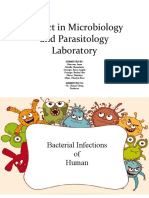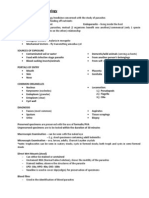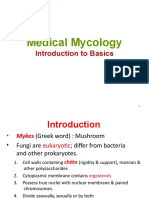Scrub Typhus
Scrub Typhus
Uploaded by
itsankurzCopyright:
Available Formats
Scrub Typhus
Scrub Typhus
Uploaded by
itsankurzOriginal Description:
Original Title
Copyright
Available Formats
Share this document
Did you find this document useful?
Is this content inappropriate?
Copyright:
Available Formats
Scrub Typhus
Scrub Typhus
Uploaded by
itsankurzCopyright:
Available Formats
Scrub typhus or Bush typhus is a form of typhus caused by the intracellular parasiteOrientia tsutsugamushi, a Gramnegative -proteobacterium of family Rickettsiaceae
first isolated and identified in 1930 in Japan.[1][2] Although the disease is similar in presentation to other forms of typhus, its pathogen is not anymore included in genus Rickettsia with the typhus bacteria proper, but in Orientia. The disease is thus frequently classified separately from the other typhi. Causes and geographical distribution[edit] Scrub typhus is transmitted by some species of trombiculid mites ("chiggers", particularlyLeptotrombidium deliense),[3] which are found in areas of heavy scrub vegetation. The bite of this mite leaves a characteristic black eschar that is useful to the doctor for making the diagnosis. Scrub typhus is endemic to a part of the world known as the tsutsugamushi triangle(after O. tsutsugamushi).[2] This extends from northern Japan and far-eastern Russia in the north, to the territories around the Solomon Sea into northern Australia in the south, and to Pakistan and Afghanistan in the west. [4] The precise incidence of the disease is unknown, as diagnostic facilities are not available in much of its large native range which spans vast regions of equatorial jungle to the sub-tropics. In rural Thailand and in Laos, murine and scrub typhus accounts for around a quarter of all adults presenting to hospital with fever and negative blood cultures [5] [6] The incidence in Japan has fallen over the past few decades, probably due to land development driven decreasing exposure, and many prefectures report fewer than 50 cases per year.[7][8] It affects females more than males in Korea, but not in Japan,[9] and this is conjectured to be because sex-differentiated cultural roles have women tending garden plots more often, thus being exposed to plant tissues inhabited by chiggers. The incidence is increasing day-by-day in southern part of Indian Peninsula. Symptoms and signs[edit] Symptoms include fever, headache, muscle pain, cough, and gastrointestinal symptoms. More virulent strains of O. tsutsugamushi can cause hemorrhaging and intravascular coagulation. Morbilliform rash, eschar, splenomegaly and lymphadenopathies are typical signs.Leukopenia and abnormal liver function tests are commonly seen in the early phase of the illness. Pneumonitis, encephalitis, andmyocarditis occur in the late phase of illness. Acute scrub typhus appears to improve viral loads in patients with HIV.[10] This interaction is challenged by an in vitro study.[11] Diagnosis[edit] In endemic areas, diagnosis is generally made on clinical grounds alone. Where there is doubt, the diagnosis may be confirmed by a laboratory test such as serology. The choice of laboratory test is not straightforward, and all currently available tests have their limitations. [12] The cheapest and most easily available serological test is the Weil-Felix test, but this is notoriously unreliable.[13] The gold standard is indirect immunofluorescence,[14] but the main limitation of this method is the availability of fluorescent microscopes, which are not often available in resource-poor settings where scrub typhus is endemic. Indirect immunoperoxidase (IIP) is a modification of the standard IFA method that can be used with a light microscope, [15] and the results of these tests are comparable to those from IFA.[13][16] Rapid bedside kits have been described that produce a result within one hour, but the availability of these tests are severely limited by their cost.[13] Serological methods are most reliable when a fourfold-rise in antibody titre is looked for. If the patient is from a non-endemic area, then diagnosis can be made from a single acute serum sample. [17] In patients from endemic areas, this is not possible because antibodies may be found in up to 18% of healthy individuals. [18] Other methods include culture and PCR, but these are not routinely available[19] and the results do not always correlate with serological testing,[20][21][22] and are affected by prior antibiotic treatment.[23] The currently available diagnostic methods have been summarised.[12] Treatment[edit] Without treatment, the disease is often fatal. Since the use of antibiotics, case fatalities have decreased from 4%40% to less than 2%. The drug most commonly used is doxycycline; but chloramphenicol is an alternative. Strains that are resistant to doxycycline and to chloramphenicol are common in northern Thailand. [24][25] Rifampin and azithromycin[26] are alternatives.[27] Azithromycin is an alternative in children[28] and pregnant women with scrub typhus,[29][30][31] and when doxycycline-resistance is suspected. [32] Ciprofloxacin cannot be used safely in pregnancy and is associated with stillbirths and miscarriage. [31][33] Combination therapy with doxycycline and rifampicin is not recommended due to possible antagonism. [34] Other drugs that may be effective are clarithromycin, roxithromycin, and the fluoroquinolones, but there is no clinical evidence on which to recommend their use. Azithromycin or chloramphenicol is useful for infection in children or pregnant women. Vaccine[edit] There are currently no licensed vaccines available.[35] An early attempt to create a scrub typhus vaccine occurred in the United Kingdom in 1937 (with the Wellcome Foundation infecting around 300,000 cotton rats in a classified project called "Operation Tyburn"), but the vaccine was not used.[36] The first known batch of scrub typhus vaccine actually used to inoculate human subjects was despatched to India for use by Allied Land Forces, South-East Asia Command (A.L.F.S.E.A.) in June 1945. By December 1945, 268,000 cc. had been despatched.[37] The vaccine was produced at Wellcomes laboratory at Ely Grange, Frant, Sussex. An attempt to verify the efficacy of the vaccine by using a placebo group for comparison was vetoed by the military commanders, who objected to the experiment.[38] It is now known that there is enormous antigenic variation in Orientia tsutsugamushi strains,[39][40] and immunity to one strain does not confer immunity to another. Any scrub typhus vaccine should give protection to all the strains present locally, in order to give an acceptable level of protection. A vaccine developed for one locality may not be protective in another locality, because of antigenic variation. This complexity continues to hamper efforts to produce a viable vaccine. [41]
You might also like
- Lumbering in CanadaDocument2 pagesLumbering in Canadaitsankurz75% (4)
- 2016 Copy of ASHE Risk Assessment Tool For NFPA 99Document5 pages2016 Copy of ASHE Risk Assessment Tool For NFPA 99tom ohnemusNo ratings yet
- Swallow Screening ToolDocument1 pageSwallow Screening Toolidris Lajide100% (1)
- Trichomoniasis: T. Vaginalis Is A Parasitic Protozoan, and The Taxonomic Position Is Based On The ClassificationDocument15 pagesTrichomoniasis: T. Vaginalis Is A Parasitic Protozoan, and The Taxonomic Position Is Based On The Classificationrave robNo ratings yet
- Bacterial Infections of Human ProjectDocument29 pagesBacterial Infections of Human ProjectCute AkoNo ratings yet
- Introduction To Parasitology PDFDocument17 pagesIntroduction To Parasitology PDFArianna Aparte AvenidoNo ratings yet
- Opportunistic Infections PDFDocument88 pagesOpportunistic Infections PDFironbuang100% (1)
- Syphilis in PregnancyDocument17 pagesSyphilis in PregnancyYinlerLeeNo ratings yet
- StreptococciDocument40 pagesStreptococciGjfyigyivNo ratings yet
- Infection Prevention ControlDocument9 pagesInfection Prevention ControlIchilon Tamoto0% (1)
- CDC 1 IntroDocument174 pagesCDC 1 Introdemessie diriba100% (1)
- Infectious Diseases of The HeartDocument84 pagesInfectious Diseases of The HeartHarold DiasanaNo ratings yet
- Chapter 21. Infections of The EyesDocument8 pagesChapter 21. Infections of The EyesZin LimNo ratings yet
- Pathogenesis of Bacterial Infection and Nosocomial InfectionDocument56 pagesPathogenesis of Bacterial Infection and Nosocomial InfectionDenise Johnson0% (1)
- 24 05 2021 Floroquinolones DR - Syeda ZainDocument46 pages24 05 2021 Floroquinolones DR - Syeda ZaintehreemNo ratings yet
- Am Positive Rods-1Document73 pagesAm Positive Rods-1temesgensemahegn55No ratings yet
- Nosocomial InfectionDocument57 pagesNosocomial InfectionFaith Ho100% (1)
- Course Syllabus Exam Micro paraDocument18 pagesCourse Syllabus Exam Micro paralanie_jecielNo ratings yet
- 4.3. Blood and Tissue NematodesDocument89 pages4.3. Blood and Tissue NematodesRediat Gossaye100% (1)
- Infection Control MeasuresDocument33 pagesInfection Control Measuresclaire yowsNo ratings yet
- FCH, Communicable Diseases Syllabus (2020)Document277 pagesFCH, Communicable Diseases Syllabus (2020)jean uwakijijweNo ratings yet
- Biology 25: Human Biology: Prof. Gonsalves Los Angeles City College Loosely Based On Mader's Human Biology, 7 EditionDocument36 pagesBiology 25: Human Biology: Prof. Gonsalves Los Angeles City College Loosely Based On Mader's Human Biology, 7 EditionRhaine EstebanNo ratings yet
- .Gram Negative Bacterias . .Document19 pages.Gram Negative Bacterias . .Nidhi Singh ThakurNo ratings yet
- Mycology QuestionsDocument17 pagesMycology QuestionsBenyam ZenebeNo ratings yet
- Lesson1 - Measles. Rubella. Chicken Pox. Herpes Zoster. Scarlet Fever. PseudotuberculosisDocument84 pagesLesson1 - Measles. Rubella. Chicken Pox. Herpes Zoster. Scarlet Fever. PseudotuberculosisDeep SleepNo ratings yet
- Salmonella Typhi (S. Typhi) - Common Worldwide, It Is Transmitted by The Fecal-Oral RouteDocument4 pagesSalmonella Typhi (S. Typhi) - Common Worldwide, It Is Transmitted by The Fecal-Oral Routehsiria100% (1)
- Oportunistic InfectionDocument20 pagesOportunistic InfectionIsman SandiraNo ratings yet
- Stool ExaminationDocument6 pagesStool Examinationwycliffe kiprotichNo ratings yet
- MC Question Bank For Quiz 2Document11 pagesMC Question Bank For Quiz 2necrodamien100% (1)
- Emerging & Remerging Parasitic DiseasesDocument27 pagesEmerging & Remerging Parasitic DiseasesNeha SamalNo ratings yet
- Respiratory Tract InfectionsDocument42 pagesRespiratory Tract InfectionsRoshana MallawaarachchiNo ratings yet
- 2-Blood and Tissue FlagelatesDocument76 pages2-Blood and Tissue FlagelatesAbdurahman TainyNo ratings yet
- Medical Dan Surgical AsepsisDocument49 pagesMedical Dan Surgical AsepsisTahtawi 'Afid' Rifai RidhoNo ratings yet
- Bot 101 NotesDocument2 pagesBot 101 NotesAbid Hussain100% (1)
- Mikrobiologi Virus ArthropodeDocument55 pagesMikrobiologi Virus Arthropodeakun scribNo ratings yet
- Syphilis BasicsDocument82 pagesSyphilis Basicstummalapalli venkateswara raoNo ratings yet
- NeisseriaDocument32 pagesNeisseriaKeshant Samaroo100% (1)
- Chapter 20. Infections of The Urinary TractDocument8 pagesChapter 20. Infections of The Urinary TractZin Lim100% (1)
- CHAPTER 16 MicroparaDocument46 pagesCHAPTER 16 MicroparaKathlyn LopeñaNo ratings yet
- Introduction To Parasitology-MergedDocument55 pagesIntroduction To Parasitology-MergedSammy MirandaNo ratings yet
- Rickettsial DiseasesDocument44 pagesRickettsial DiseasesPrince AlexNo ratings yet
- Zika Virus: TransmissionDocument3 pagesZika Virus: TransmissionMarlie VillanuevaNo ratings yet
- Clinical VirologyDocument31 pagesClinical VirologySally ElhadadNo ratings yet
- Anaerobic InfectionsDocument57 pagesAnaerobic Infectionsentistde0% (1)
- HistoplasmosisDocument12 pagesHistoplasmosis사이맄 진No ratings yet
- Chlamydiae: Dr. Aye Mi San Assistant LecturerDocument32 pagesChlamydiae: Dr. Aye Mi San Assistant LecturerNaing Lin SoeNo ratings yet
- AntiviralDocument15 pagesAntiviralBrianDiazNo ratings yet
- Introduction To MycologyDocument39 pagesIntroduction To MycologyElena ShresthaNo ratings yet
- Infection AIDS Upload 17thDocument87 pagesInfection AIDS Upload 17thtummalapalli venkateswara rao100% (1)
- Hepatitis A, D, E & GDocument28 pagesHepatitis A, D, E & GsaleemNo ratings yet
- Virology Respiratory VirusesDocument6 pagesVirology Respiratory VirusesHisham ChomanyNo ratings yet
- Chairuddin P. Lubis Department of Pediatrics Faculty of Medicine University of Sumatera Utara MedanDocument46 pagesChairuddin P. Lubis Department of Pediatrics Faculty of Medicine University of Sumatera Utara MedanVinod RajNo ratings yet
- Tetanus, Botulisn, Gas GangreneDocument87 pagesTetanus, Botulisn, Gas GangreneTarik100% (1)
- Campylobacter Jejuni: Dr. Abdulaziz BamaroufDocument29 pagesCampylobacter Jejuni: Dr. Abdulaziz BamaroufaobamaroufNo ratings yet
- Bacterial Meningitis: - Maria Christma B. UmbañaDocument22 pagesBacterial Meningitis: - Maria Christma B. UmbañaMaria Christma UmbanaNo ratings yet
- Fungi & Systemic MycosesDocument49 pagesFungi & Systemic MycosesAmal ShereefNo ratings yet
- Virulence Factor of E. ColiDocument26 pagesVirulence Factor of E. ColiNazii Baig100% (1)
- Infection Control PrinciplesDocument53 pagesInfection Control PrinciplesHasan A AsFourNo ratings yet
- Introduction To Medical Parasitology Prepared By: Geraldine P. PulidoDocument26 pagesIntroduction To Medical Parasitology Prepared By: Geraldine P. PulidoMark Reynie Renz SilvaNo ratings yet
- SYPHILISDocument6 pagesSYPHILISKhristine Dyanne San JoaquinNo ratings yet
- Immunodeficiency and AIDSDocument38 pagesImmunodeficiency and AIDSqianyuNo ratings yet
- 5.infection Control & Standard PrecautionsDocument33 pages5.infection Control & Standard PrecautionsGilbert JohnNo ratings yet
- BacteriologyDocument15 pagesBacteriologyAnha Dewi OctaviaNo ratings yet
- Excel BasicsDocument17 pagesExcel BasicsitsankurzNo ratings yet
- Subject Complaint Against Garbage Picker in My Shop Gaytri Computers, Main Bazaar, Sanjauli, Shimla - 6Document1 pageSubject Complaint Against Garbage Picker in My Shop Gaytri Computers, Main Bazaar, Sanjauli, Shimla - 6itsankurzNo ratings yet
- Vandana Kumari: Career ObjectiveDocument2 pagesVandana Kumari: Career ObjectiveitsankurzNo ratings yet
- Application Form For Appointment of Supervisors (On Contract) in Labour BureauDocument2 pagesApplication Form For Appointment of Supervisors (On Contract) in Labour BureauitsankurzNo ratings yet
- Yogesh NegiDocument2 pagesYogesh NegiitsankurzNo ratings yet
- Famous SikhDocument6 pagesFamous SikhitsankurzNo ratings yet
- Importance of SleepDocument9 pagesImportance of SleepitsankurzNo ratings yet
- Tundra Land Taiga Land: Temperate Grasslands Desert and Semi DesertDocument2 pagesTundra Land Taiga Land: Temperate Grasslands Desert and Semi DesertitsankurzNo ratings yet
- InternetDocument4 pagesInternetitsankurzNo ratings yet
- Famous SikhDocument6 pagesFamous SikhitsankurzNo ratings yet
- Famous Sikhs: Dr. Narinder Singh KapanyDocument2 pagesFamous Sikhs: Dr. Narinder Singh KapanyitsankurzNo ratings yet
- Indian DancesDocument7 pagesIndian DancesitsankurzNo ratings yet
- Pedo Seminar New On Space MainainerDocument38 pagesPedo Seminar New On Space MainainerAnkur SahuNo ratings yet
- Wendlyn ManoguraDocument52 pagesWendlyn ManoguraAivy Mejos BanawaNo ratings yet
- Blood Donation Aplication FormDocument6 pagesBlood Donation Aplication FormSidney WatersNo ratings yet
- Department of Molecular Biology. Covid 19 Test Name Result Unit Bio. Ref. Range MethodDocument2 pagesDepartment of Molecular Biology. Covid 19 Test Name Result Unit Bio. Ref. Range Methodvamsi krishnaNo ratings yet
- Nurse ResumeDocument1 pageNurse Resumeapi-400113721No ratings yet
- 2020 Primary One Registration Exercise Application Form: Phase 1Document1 page2020 Primary One Registration Exercise Application Form: Phase 1Suresh ThevanindrianNo ratings yet
- Hospice Admission Nurse ResumeDocument4 pagesHospice Admission Nurse Resumeqwaskmrmd100% (1)
- Ethiopia - Cholera Flash Update #7Document4 pagesEthiopia - Cholera Flash Update #7assefamenelik1No ratings yet
- Health and Social Problems of Street Children: Original ArticleDocument7 pagesHealth and Social Problems of Street Children: Original ArticleTmiky GateNo ratings yet
- Unit 9 Episiotomy and Nursing Management: 9.0 ObjectivesDocument8 pagesUnit 9 Episiotomy and Nursing Management: 9.0 ObjectivesSudip Kumar DeyNo ratings yet
- Health Melcs Grade 1Document3 pagesHealth Melcs Grade 1Angelito Garciso JrNo ratings yet
- Benavides Lecture-Reaction PaperDocument3 pagesBenavides Lecture-Reaction PaperLuthor Ace VillalvaNo ratings yet
- RH LAW Reproductive Health L PhilippinesDocument12 pagesRH LAW Reproductive Health L PhilippinesJulius Carmona GregoNo ratings yet
- A Review of Age Friendly Cities and HealDocument9 pagesA Review of Age Friendly Cities and HealKuheli ChowdhuryNo ratings yet
- Texas: Medical Cannabis Resource Document - Digital Edition-CompressedDocument638 pagesTexas: Medical Cannabis Resource Document - Digital Edition-Compressedinvictusatx100% (2)
- Blood Donation InfomercialDocument3 pagesBlood Donation InfomercialSheila YapNo ratings yet
- Add-Walk in InterviewDocument5 pagesAdd-Walk in InterviewshahbazNo ratings yet
- 6-Year-Follo Up. 3 Steps Techniques. Francesca Valati-1 PDFDocument25 pages6-Year-Follo Up. 3 Steps Techniques. Francesca Valati-1 PDFAdriana CoronadoNo ratings yet
- CASP Case Control Drug ToxicityDocument6 pagesCASP Case Control Drug ToxicityNani Lestari Kendek AlloNo ratings yet
- Name - Bai Allay-WPS OfficeDocument2 pagesName - Bai Allay-WPS OfficeDatuesmail Ala AliNo ratings yet
- Mercy Health Partners: Case StudyDocument1 pageMercy Health Partners: Case StudyStacey SalvillaNo ratings yet
- School of MedicineDocument10 pagesSchool of MedicineDuaa HadoupNo ratings yet
- Natalie Alwin BMT Resume SusieDocument1 pageNatalie Alwin BMT Resume Susieapi-340258456No ratings yet
- Group 4 - Case 4Document16 pagesGroup 4 - Case 4Anindya AisyahNo ratings yet
- TSU Statement For CHEDDocument2 pagesTSU Statement For CHEDJazzel ManaloNo ratings yet
- Health Optimizing Physical Education 4 (Gr. 12 - 2 Semester)Document1 pageHealth Optimizing Physical Education 4 (Gr. 12 - 2 Semester)Heiden Mae AleNo ratings yet
- Legea 46 2003Document2 pagesLegea 46 2003dstfyhjgNo ratings yet
- Factors Associated With Severe Malaria in Children Under Five Years of Age at Mbarara Regional Referral Hospital, UgandaDocument12 pagesFactors Associated With Severe Malaria in Children Under Five Years of Age at Mbarara Regional Referral Hospital, UgandaKIU PUBLICATION AND EXTENSIONNo ratings yet





































































































